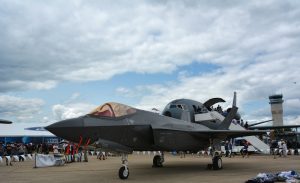By Jacob Parakilas

On March 16, the British government released the “Integrated Review of Security, Defense, Development and Foreign Policy,” its all-encompassing roadmap for the future of its defense and foreign policy. It proposed transformative changes to the structure of the U.K.’s armed forces and officially launched Brexit Britain’s strategic “tilt to the Indo-Pacific.”
But transformation is a tricky thing. Given the long timelines for military procurement, the complexity of maintaining a defense industrial base, and the inertia produced by the interplay between those two factors, matching hard capabilities to lofty strategic language is difficult.
Take as an example two of the highest-profile pieces of military hardware in Britain’s arsenal, the carrier HMS Queen Elizabeth and the F-35B Lightning II. The new carrier is the largest ship ever built for the Royal Navy and has been designated the flagship for the entire fleet. To underscore the seriousness of the government’s Indo-Pacific aspirations, its inaugural operational cruise will be to the Pacific, where it may traverse the South China Sea over Beijing’s objections.
Sending a carrier battle-group — a significant portion of the Royal Navy’s entire deployable combat strength — to the far side of the world certainly sends a message. But that message may well be diluted by operational factors.
A carrier is nothing if not a platform: the ship’s own weapons are solely designed for self-defense (and in the case of the British ships, extremely limited even for that task). And the capabilities of the Queen Elizabeth class are unusually strongly linked to a single aircraft. Aside from helicopters to provide search and rescue, light resupply, and airborne radar coverage, the ship’s entire air wing will be composed of F-35s.
The U.K. was a core partner in the development of the F-35, particularly the vertical/short takeoff and landing (V/STOL) B-variant — which composes the entirety of the U.K.’s order of the type. In fact, the design of Britain’s multibillion-pound carriers was dependent upon the success of the program. Unlike the carriers of the French and U.S. navies, Britain’s are equipped with ski-jumps: an inclined section of the bow, which gives an aircraft additional lift to compensate for the shortened length of its takeoff roll.
Conventional aircraft can take off from ski-jumps; the Chinese, Russian and Indian navies all operate ski-jump carriers with non-V/STOL aircraft. But not without penalty: aircraft operating from those carriers can only carry a fraction of the fuel and payload of those launched by catapult, which limits their usefulness. And landing a conventional jet — something of a requirement for effective carrier operations — requires arrestor gear, which the Queen Elizabeth is not equipped with. So, the only fixed-wing aircraft that can both take off and land from it is the F-35. (In theory the older Harrier could as well, but it left British service in 2010 and is approaching the end of its life with the U.S. Marines).
Vertical takeoff has advantages — reducing the need for long, vulnerable runways, adding maneuverability in close-range combat — but equally significant drawbacks: mechanical complexity, enormous fuel consumption, added weight, more limited payload, and damage to runway surfaces from their extremely hot exhaust plumes. Helicopters and small drones can extract maximal advantage from vertical takeoff capabilities, but as aircraft get faster and heavier, the penalties of V/STOL increases rapidly.
Those disadvantages — exacerbated by the F-35’s extended, torturous entry into service — may explain why there are not any other vertical takeoff jets in the development pipeline, at least as far as the public is aware. That, in turn, limits the value of a ski-jump carrier as a platform. Since it can only operate a single type of jet, missions that are beyond that jet’s capabilities also erase the carrier’s value. And the Pacific, where long-range missions are likely to be the norm, is not the best use case for a V/STOL jet.
And on top of all that, the F-35 may not be affordable for the U.K. In line with persistent rumors, the Integrated Review confirms that the U.K. will have “at least” 48 F-35s by 2025. Forty-eight F-35s, given training and maintenance needs and expected attrition, is barely enough to maintain a meaningful air group aboard Queen Elizabeth, and completely inadequate to simultaneously embark on both it and Britain’s second carrier, HMS Prince of Wales.
Parenthetically, it is worth noting some historical resonance here. The last ship to bear the name Prince of Wales was a new battleship sunk alongside HMS Repulse by Japanese bombers shortly after the attack on Pearl Harbor, in an early but influential demonstration of the vulnerability of traditional capital ships to air attack even while underway.
Certainly, governments and industry are exploring ways to procure aircraft less expensively and more flexibly. So, it is likely that, over time, the Royal Navy’s carriers could develop a more diversified air group — even if building ski-jump capable aircraft is a very small market and likely uneconomical for most aerospace companies. Until and unless that happens, there will remain a significant gap between Britain’s stated strategic ambitions in the Indo-Pacific and its ability to act on them.
No comments:
Post a Comment